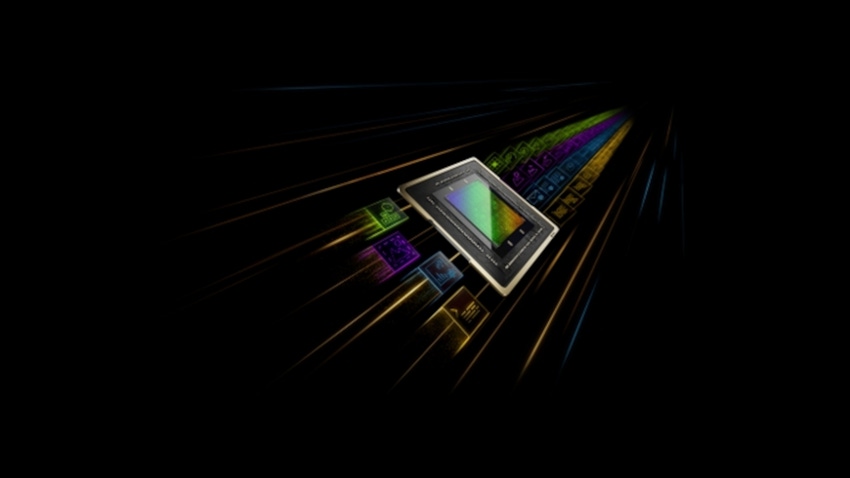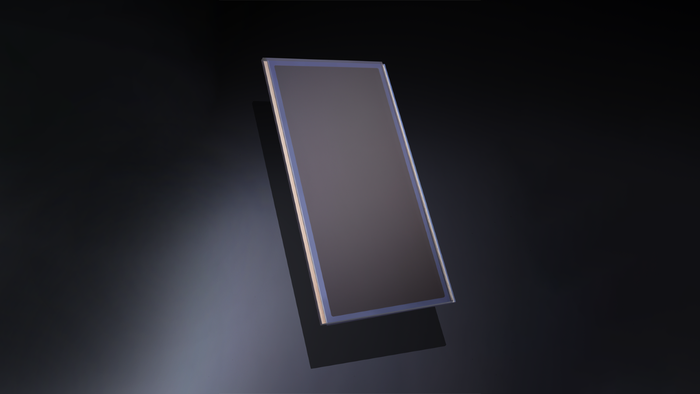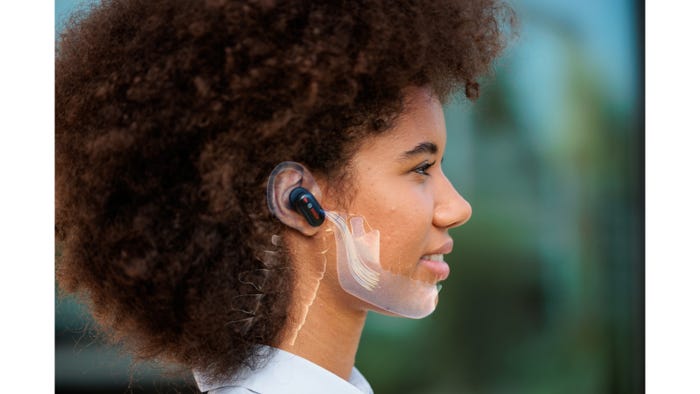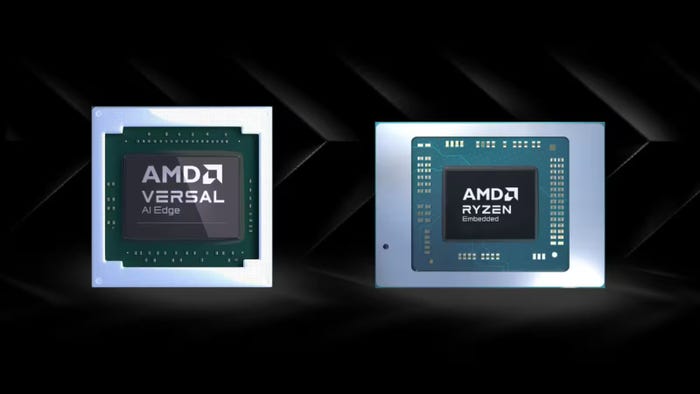At CES: Electronics Innovations Driving Next-Gen Products
Hardware and software advances target future IoT, vehicle, AI apps.

The Consumer Electronics Show (CES) was for many years a hotbed for innovations in consumer electronics such computers and audio. More recently, products such as smartphones, wearables, and even advanced vehicles have become the darlings of the show. But underneath the glitz of these products are the nuts-and-bolts developments that make these possible─sensors, processors, embedded systems, displays, and other components, as well as software. At CES 2024, innovative hardware and software advances will once again be on display.
Solar Cell Technology
Ambient Photonics is demonstrating a solar cell technology the company claims can replace traditional batteries for powering remotes, keyboards, speakers, and more. The company has developed a dye-sensitized solar cell (DSSC) that reportedly can deliver up to three times more power than other indoor solar solutions in very low-light conditions.
The company’s solar cell technology leverages materials developed through molecular engineering, according to Bates Marshall, co-founder and CEO, in a recent interview with Design News. “With indoor solar cells, there have been limitations in power density. Some of the other candidate photovoltaic technologies would not be able to justify a large capital investment for only a modest improvement in power handling.”
Marshall, a veteran of the solar industry, added that Ambient Photonics has already built a plant designed for high-volume solar cell production in Scotts Valley, Calif. He hopes to scale up production to produce cells at a cost that compares favorably with amorphous silicon. Marshall anticipates products integrating the solar cell to be manufactured starting later this year, for applications such as remote controls, keyboards and mice, and electronic shelf labels. One customer is Universal Electronics, a supplier of remote controls.
During CES 2024, Ambient Photonics is demonstrating the abilities of the company’s first bifacial solar cell, which can harvest light energy from the back and front of the solar cell simultaneously. Designed into a remote control, for example, an Ambient Photonics-powered device with a bifacial cell could power itself whether it rests face-up or face-down on a coffee table.

Ambient Photonics has developed a solar cell technology that reportedly provides three times the power of other indoor solar cell solutions in low-light conditions. (Photo courtesy of Ambient Photonics).
Because light power can be harvested from two sides, devices that include Ambient Photonics Low-Light Indoor Bifacial Solar Cell technology can produce more energy, boosting cell efficiency and enabling more powerful electronics. The front side of an Ambient bifacial solar cell delivers 100% of the power that Ambient’s cells are known for, while the back side delivers at least 50% of the energy as the front side.
Tiny Accelerometers
Bosch Sensortec has announced the BMA530 and BMA580, reportedly the world's smallest MEMS accelerometers. Both devices include built-in features making them easy to design with. BMA530 tracks activities with its step counter and is especially suitable for wearables, and BMA580 targets hearables with voice activity detection.
Compared to Bosch's current generation accelerometer (BMA253), the BMA530 and BMA580 have a 76% smaller footprint and have been reduced in height from 0.95 mm to 0.55 mm. This size reduction is achieved with an innovative Wafer Level Chip Scale Package (WLCSP). The small size of the accelerometers makes them easy to place on a PCB, and their integrated features make them easy for design engineers to integrate into their portable products.
The BMA580 provides innovative voice activity detection and an advanced feature set for hearable devices. Typically, microphones in hearables consume a lot of power because they need to be always-on to listen for voice activity. Instead, the BMA580 uses bone conduction to detect the vibration of the user’s voice and then wakes the microphone from sleep–for an overall power saving. The BMA580 enables user interaction with a hearable in response to the user tapping the device, for example to answer or end a call. The sensor’s software includes an algorithm that can distinguish between single, double and triple taps.

Bosch Sensortec’s BMA 580 MEMS accelerometers provides voice activity protection and an advanced feature set for hearable devices. (Photo courtesy of Bosch Sensortec)
In addition to wearables, the new BMA530 acceleration sensor is ideal for gesture recognition in toys, fall detection in laptops and other devices, and power management functions such as putting a smartphone to sleep when it is not moved.
Both accelerometers offer multiple power modes and automatically switch from low-power to high-power modes to extend battery life. They offer a flexible set of connectivity options, including an I3C® interface.
Wi-Fi 7
Don’t look now, but Wi-Fi 7 is coming. Ceva, Inc. a licensor of silicon and software IP that enables Smart Edge devices to connect, sense and infer data more reliably and efficiently, is releasing its next generation RivieraWaves Wi-Fi 7 IP platform. The platform further expands the company’s portfolio of connectivity IP, targeting high-end consumer and industrial applications including gateways, TVs, set-top-boxes, streaming media devices, AR/VR headsets, personal computing, and smartphones.
The RivieraWaves Wi-Fi 7 IP leverages all the latest advanced features of the IEEE 802.11be standard to deliver a premium high performance, cost- and power-optimized Wi-Fi solution for integration into the next wave of Wi-Fi Access Point (AP) and Station (STA) products.
Wi-Fi 7's 4K QAM modulation scheme is a substantial increase on the previous 1K QAM of Wi-Fi 6, while Multi Link Operation (MLO) introduces dynamic channel aggregation, seamlessly combining heterogenous channels from the same or different bands to navigate interference and boost throughput. Similarly, Multi Resource Units (MRU) enables the creation of larger channel bandwidths by intelligently stitching together punctured or disjointed Resource Units within the same band. The outcome is not only a 5X increase in raw speeds, but also reduced latency, thanks to diminished contentions and retries.
SoC for IoT
Atmosic Technologies, a supplier of ultra-low-power wireless platforms for the Internet of Things (IoT), is unveiling the ATM34/e high-performance system-onchip (SoC) series with multiprotocol support. The ATM34/e series adds support for IEEE 802.15.4 based protocols including Thread and Matter, as well as enhanced Bluetooth LE support for the latest 5.4 standard revision. Atmosic’s ATM34/e series is designed for ultra-low power end IoT devices such as sensors and switches and typically uses 50% less active energy than competitor solutions.
The SoCs incorporate Atmosic’s best-in-class radio, consuming less than 1 mA in receive mode, and an energy-efficient transmitter with an output power range from -20 dBm to +10 dBm. These power-saving innovations extend battery life in connected devices and can even enable some devices to operate battery-free.
With a new scalable memory architecture, the ATM34/e series allows developers to use a memory footprint that meets the needs of their protocol, application, and cost targets. The ATM34/e series integrates a 64 MHz Arm® Cortex® M33F processor to optimize power and performance, while also supporting Arm’s TrustZone® technology for robust security. The ATM34/e series enables devices to efficiently capture, use, and store energy from RF, heat, light, and motion sources. It is designed to support a wide range of storage devices which enables smart sensors and other low power automation applications to operate unattended for years.
LiDAR On a Chip
SILC Technologies launched the Eyesonic Vision System Mini, which integrates a multi-channel LIDAR on a single silicon photonic chip and an integrated FMCW LIDAR system-on-chip. According to the company, the system delivers an order of magnitude greater precision while being one-third the size of its predecessor model introduced last year. The precision is expected to be useful in warehouse logistics and AI machine vision applications (see photo).

SILC Technologies’ Eyesonic Vision System Mini integrates a multi-channel LIDAR on a single silicon photonic chip and an integrated FMCW LIDAR system-on-chip. (Photo courtesy of SILC Technologies)
And Don’t Forget AI
Not surprisingly, AI-related announcements are in abundance at CES. Toward this end, NVIDIA made a host of announcements. These include the GeForce RTX SUPER desktop GPUs, and NVIDIA RTXTM-accelerated AI software and tools for both developers and consumers.
The NVIDIA RTX GPUs are designed to unlock the full potential of generative AI on PCs. The Tensor Cores in SUPER GPUs deliver up to 836 trillion operations per second, bringing transformative AI capabilities to gaming, creating and everyday productivity.
NVIDIA has also unveiled its GeForce RTX 40 SUPER Series graphics cards, including the GeForce RTX 4080 SUPER, 4070 Ti SUPER and 4070 SUPER for top AI performance.
Other NVIDIA announcements include:
● NVIDIA RTX Remix, a platform for creating stunning RTX remasters of classic games.
.● NVIDIA ACE microservices, including generative AI-powered speech and animation models, which enable developers to add intelligent, dynamic digital avatars to games.
● NVIDIA DLSS 3 with Frame Generation, which uses AI to increase frame rates up to4x compared with native rendering, will be featured in a dozen of the 14 new RTX games announced, including Horizon Forbidden West, Pax Dei and Dragon’s Dogma 2.
● Chat with RTX, an NVIDIA tech demo available later this month, allows AI enthusiasts to easily connect PC LLMs to their own data using a popular technique known as retrieval-augmented generation (RAG).
AI and Automotive Processors
AMD announced its Versal™ AI Edge XA adaptive SoC and Ryzen™ Embedded V2000A Series processors. The Versal AI Edge XA adaptive SoCs add an advanced AI Engine, enabling the devices to be further optimized for numerous next-generation advanced automotive systems and applications including: forward cameras, in-cabin monitoring, LiDAR, 4D radar, surround-view, automated parking and autonomous driving. Versal AI Edge XA adaptive SoCs are also the first AMD 7nm device to be auto-qualified, bringing hardened IP and added security to automotive applications where safety is paramount.
Versal AI Edge XA adaptive SoCs can perform AI inference on large ingests of data. They can also be used in edge sensors, such as LiDARs, radars and cameras, or in a centralized domain controller. The AI Engines are capable of handling different types of AI models such as classification and feature tracking. This device portfolio ranges from 20k LUTs to 521k LUTs, and from 5 TOPs to 171 TOPs.
The automotive-grade AMD Ryzen Embedded V2000A Series processor enables carmakers to deliver impressive performance and multitasking for infotainment and IVX systems so passengers can stay connected on the go.
Built on 7-nm process technology, ‘Zen 2’ cores and high-performance AMD Radeon Vega 7 graphics, the AMD Ryzen Embedded V2000A Series processor provides a new class of performance. It delivers high-definition graphics, with enhanced security features and automotive software enablement through hypervisors in addition to support for Automotive Grade Linux and Android Automotive.

AMD’s AI Edge XA Adaptive SoC and Ryzen Embedded V2000A Series processor bring AI capabilities to vehicle systems. (Photo courtesy of AMD)
About the Author(s)
You May Also Like



.jpg?width=300&auto=webp&quality=80&disable=upscale)

